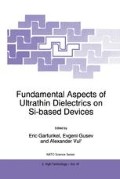Abstract
The paper is devoted to the investigation of current instabilities in the Al-Si0 2 - n-Si Auger, transistor. We succeeded for the first time in creating of the Auger transistor, in which in particular we used a metal-insulator heterojunction instead of a widegap semiconductor. The Auger transistor base is created by the holes, which are induced on silicon surface by electric field that exists in the thin oxide layer and is formed as a self-consistent quantum well near the n-silicon surface. The base width’ is about 10 Å and the well depth is equal up to 0.7 eV or even higher. The generation of electron-hole pairs by impact ionization (Auger generation) is the fastest physical process in semiconductors, which can be used for amplification and generation of electric signals. The impact ionization and drift regions are practically separated in the Auger transistor. The electron-hole pairs are generated in the transistor base and partly in the collector. The Sand N-type instabilities of the collector current in the Auger transistor in the case of circuit with a common emitter were investigated.
Access this chapter
Tax calculation will be finalised at checkout
Purchases are for personal use only
Preview
Unable to display preview. Download preview PDF.
References
Simmons, J.G. and Taylor, G.W. (1986) Concepts of gain at an oxide-semiconductor interface and their application to the TETRAN and to the MIS switching device, Solid-State Electronics, 29 287–303.
Kroemer, H. (1972) in the book: A.G. Milns and J.J. Feucht, Heterojunctions and Metal-Semiconductor Junctions, New York, NY: Academic Press.
Grekhov, I.V., Ostroumova, E.V., Rogachev, A.A. and Shulekin, A.F. (1991) A silicon Auger transistor with a tunnel MIS emitter, Pis’ma v Zh. Tekh. Fiz., 17, 44–48, [Soy. Tech. Phys. Lett., (1991), 17 (7) 476 -477,].
Ostroumova, E.V. and Rogachev, A.A. (1994) A simple model of the Auger transistor, Fiz. Tech. Poluprovodn., 28, 1411–1423 [Semiconductors, 28 (8), 793–799 (1994)].
Tiwary, S., Wang, W.I. and East, J.R. (1990) An analytic theory of the Auger transistor: a hot electron bipolar transistor, IEEE Trans. Electron Devices, 37 1121–1131.
Ostroumova, E.V. and Rogachev, A.A. (1997) Current instabilities in the Auger transistor, Proc. of Intern. Symp. “Nanostructures: Physics and Technology”, St.-Peterburg, Russia, 456–459.
Read, W.T. (1958) A proposed high-frequency, negative-resistance diode, Bell. Syst. Techn. J., 37 401–446.
Ostroumova, E.V. and Rogachev, A.A. (1994) Quantum effects in MIS Auger-transistor, Abstr. of II Intern. Symp. “Nanostructures: Physics and Technology”, St.-Petersburg, Russia, 209–211.
Ostroumova, E.V. and Rogachev, A.A. (1996) MIS Auger transistor, Proc. of the 26th European Solid State Device Research Conference ESSDERC’96, Edit. by G.Baccarani & M.Rudan, Edition FRONTIERES, France, 245–248.
Ando, T., Fowler, A.B. and Stem, F. (1982) Electronic properties of two-dimensional system, Reviews of Modern Physics 54 438–672.
Rogachev, A.A. (1992) Electron-Hole Liquids in Semiconductors’, Handbook on Semiconductors, Completely Revised Edition, Edited by T.S. Moss, Vol.1 - Basic Properties of Semiconductors, Ed. by P.T.Landsberg, Elsevier Science Publiishers B.V., Chapter 9 p.449–487.
Ostroumova, E.V. and Rogachev, A.A. (1997) Current instabilities in the Auger transistor, Microelectronics and Reliabilities, to be published.
Chang, Chi., Hu, Ch. and Brodersen, R.W. (1985) Quantum yield of electron impact ionization in silicon, J. Appl. Phys. 57(20) 302–309.
Author information
Authors and Affiliations
Editor information
Editors and Affiliations
Rights and permissions
Copyright information
© 1998 Springer Science+Business Media Dordrecht
About this chapter
Cite this chapter
Ostroumova, E.V., Rogachev, A.A. (1998). Heterojunction Al/SiO2/n-Si Device as an Auger Transistor. In: Garfunkel, E., Gusev, E., Vul’, A. (eds) Fundamental Aspects of Ultrathin Dielectrics on Si-based Devices. NATO Science Series, vol 47. Springer, Dordrecht. https://doi.org/10.1007/978-94-011-5008-8_28
Download citation
DOI: https://doi.org/10.1007/978-94-011-5008-8_28
Publisher Name: Springer, Dordrecht
Print ISBN: 978-0-7923-5008-8
Online ISBN: 978-94-011-5008-8
eBook Packages: Springer Book Archive

